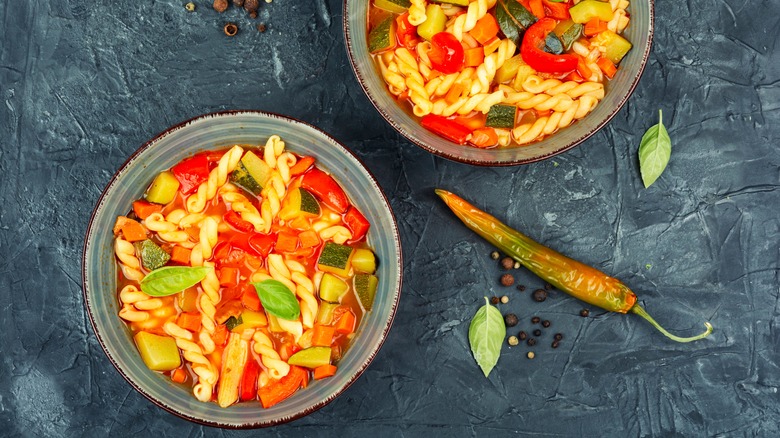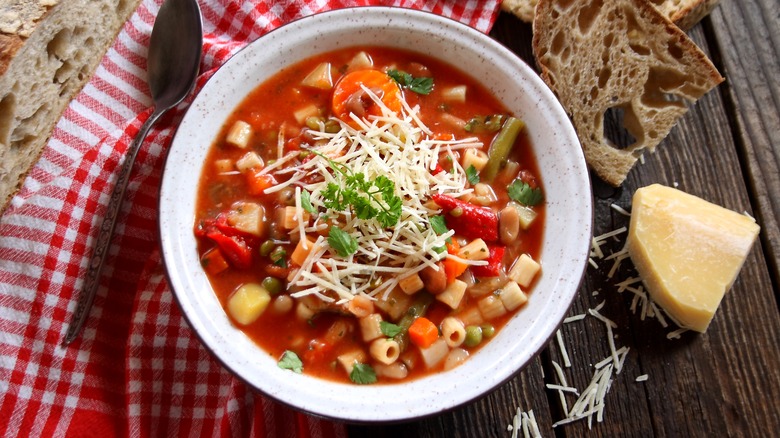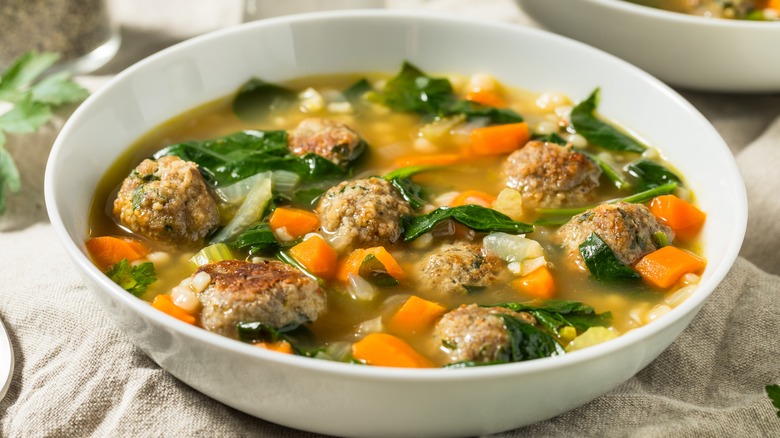Minestrone Vs Italian Wedding Soup: What's The Difference?
When you think of Italian comfort food, you might conjure up images of ooey gooey lasagna or a heaping bowl of creamy, cheesy pasta. But don't let minestrone and Italian wedding soup fly under your radar. They're both delicious, hot soups packed with vegetables and small noodles that encapsulate the rustic charm of Italian home cooking. You might even use the names for these two soups interchangeably. However, while they certainly have a number of similarities, minestrone and Italian wedding soup also have significant differences in taste and ingredients that clearly make them two distinct dishes.
Both soups are nourishing, healthy, and have become popular in kitchens worldwide. Due to the ease of making these soups and the availability of ingredients, you can whip up a warm bowl of either one on a busy weeknight by simply using up ingredients that have been taking up space in your pantry or freezer. Or if you have a little more time to leisurely make dinner, you can just as easily use fresh ingredients for an extra touch of homemade comfort.
What is minestrone soup?
Minestrone is a thick, chunky, vegetable-forward dish that contains broth, beans, and pasta, and is usually topped with Parmesan cheese. Exactly which vegetables are used varies on the season and region, but common favorites include carrots, onions, celery, potatoes, zucchini, green beans, and various herbs. The addition of beans, usually cannellini or kidney, is one of the major differences between minestrone and Italian wedding soup. Using canned beans is a quick and easy way to balance out your dish with a protein source, and there are plenty of ways to make canned beans taste homemade to really add to the coziness of this soup. A small pasta like ditalini, pearled couscous, or even rice is added to make it extra filling. Minestrone typically has a tomato base which lends an acidic and slightly sweet flavor to the savoriness of the broth and beans.
Part of the beauty of minestrone soup is that you can customize it based on your preferences or what vegetables you have on hand. Not a fan of carrots? Leave them out. Have an abundance of garden-grown zucchini stored in the freezer? Throw it in the soup! After all, using ingredients based on availability is how minestrone was born. It is categorized as a common cucina povera dish, which means poor kitchen in Italian. Italian peasants created minestrone with whatever leftover food they had so as not to waste anything. The combination of vegetables, herbs, broth, beans, and pasta made a cheap meal that was both filling and nutritious.
What is Italian wedding soup?
Italian wedding soup is also loaded with veggies, but its ingredients list may not be as extensive as minestrone. Onions, carrots, and celery are common fixtures, but leafy greens, such as spinach or kale are a big identifier of Italian wedding soup. Another major difference between it and minestrone is that Italian wedding soup typically does not contain beans and instead incorporates meatballs. You can use any type of meatball you like, be it chicken, turkey, or a more traditional combination of beef and pork (just be sure not to make any common meatball mistakes if you're whipping them up homemade). Feel free to thaw frozen meatballs if you don't have the time or energy to make them yourself.
Italian wedding soup's broth also differs from minestrone in that it is not tomato-based. The usual chicken or beef broth remains somewhat clear to show off the veggies, leafy greens, and meatballs. While this soup is just as filling and nutritious as minestrone, it is thinner, more delicate, and has a more savory flavor due to the lack of tomatoes and addition of meat.
Italian wedding soup was also considered a cucina povera dish, but its name misleadingly has nothing to do with weddings. Its name in Italian is minestra maritata, which translates to married soup. It's speculated that the "wedding" being referred to in the dish's name is between meat and vegetables, not two people. Next time you're in the mood for a cozy soup, see how many ingredients for either minestrone or Italian wedding soup you already have on hand. Now that you know the differences between them, you could even make batches of both.


